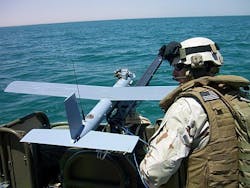Researchers ask industry for ideas on Common Data Link radios for small manpackable UAVs
IDAHO FALLS, Idaho, 21 May 2013. U.S. government researchers are asking industry for ideas on a Common Data Link (CDL) radio that is small enough to fit on small unmanned aerial vehicles (UAVs) that warfighters can carry into the field and operate with only one or two people.
Officials of the U.S. Department of Energy's Idaho National Laboratory in Idaho Falls, Idaho, have issued a request for information (13-0005) for the Common Data Link (CDL) Communications for Small Unmanned Aircraft System - Capabilities for Common Data Link (CDL) Communications for Small Unmanned Aircraft Systems (SUAS).
The RFI asks for comments from industry on technologies and potential solutions for two sets of CDL radio capabilities to support small UAVs. The Common Data Link is a secure U.S. military communications protocol for imagery and signals intelligence, and enables full-duplex data exchange.
These CDL radios should be no larger than 5.11 by 2.85 by 0.78 inches, and weigh no more than eight to ten ounces. Input voltages should be 10 and 30 volts DC, and the unit should consume no more than 20 to 35 Watts of power.
Providing CDL radios with greater data rates, frequency bands, and spectral efficiency could expand CDL use to manpackable UAVs for soldiers, Marines, and other warfighters in the field, such as the Small Tactical Unmanned Aircraft System (STUAV) under development for the Navy and Marine Corps.
CDL employment until now has not been possible on these kinds of small UAVs because of size, weight, and power (SWaP) limitations.
Researchers at the Idaho Lab are asking industry about CDL radios that include the transceiver, encryption, power amplifier, diplexer, antenna, cables, and connectors. No proprietary waveforms will be considered, officials say.
For CDL radio performance, researchers are interested in multi-band, bandwidth-efficient links in the L, S, C, and Ku bands, if possible. The radio should have a close link with the ground control station using an 8.448-megabit-per-second link.
Idaho Lab experts are assuming that the ground station has a parabolic antenna one meter in diameter, and a channel availability of 95 percent. The range should be 50 to 110 nautical miles, and the radio should support throughput from 8.448 to 44.736 megabits per second.
Officials also are interested in Suite B and unencrypted modes, ranging from Suite A and Suite B. Encryption should be operational within 90 seconds of a cold start.
Remote changes to network configurations should include IP addressing, routes, and multicasting capabilities, and full-duplex communications should be available in each of the frequency bands. Built-in-test also should be included.
Power and Ethernet connections should be via pin Micro-D connectors, with a hardware reset pin. No more than one surface may be used as a heat sink.
The transceiver should be able to operate in temperatures from -25 to 130 degrees Fahrenheit, with operation to 158 degrees preferred. The unit also should be able to operate at altitudes to 15,000 to 20,000 feet. Idaho Lab researchers are interested in ideas involving all, or a subset, of the capabilities in the RFI.
Companies interested should email 20-page white papers to the Idaho Lab's Kort Bowman at [email protected] no later than 21 June 2013. Email questions or concerns to Bowman at the same address.
More information is online at https://www.fbo.gov/spg/DOE/INEEL/ID/13-0005/listing.html.

